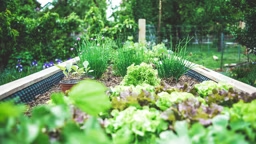
The basement of my childhood home, a 100-year-old brick house, would flood after spring snow melt and summer storms. Many mornings, I woke to the hum of the sump pump, tirelessly pushing water from the basement through a section of drainpipe draped over the gravel driveway and onto the lawn. Post-storm, this section of lawn, deluged from sump-pumped basement water, as well as rooftop water, would get wet and stressed, killing hefty patches of once healthy grass.
Every spring, the pipe would perforate and leak after we carelessly ran over it with our car, causing ice to build up on our driveway. Since it was something I grew up with, a seasonal ritual, I never thought of our runoff as something to be remedied; I just learned to go slowly over the ice on my way to the school bus and walk barefoot through the soggy grass to the garden.
Runoff was a problem that I associated with cities, not rural life. It wasn’t until many years later, after a meeting with Roger Bannerman (“Mr. Rain Garden”), that I realized soggy turf and a treacherously icy driveway did not need to be tolerated; instead, the water could be diverted and efficiently absorbed. With the help of a mini-excavator, a subsurface drain was installed to divert the water from my mom’s house to go under the driveway and lawn (instead of over) into a 15x15-foot shallow depression planted with coneflowers, cup plant and cordgrass. It was our very own rain garden! After watching a season of goldfinches and swallowtail butterflies raise their families among the native flowers, the rain garden was aptly renamed “the critter patch.”
Filtering system
Rain gardens work because they reflect ancient natural systems: Plant communities with raindrop-slowing leaf layers, natural catch basins, and thirsty soils intercept and absorb rainwater.
The gardens also act as filters. The root systems and associated porous soil of rain garden plants absorb herbicides or fertilizers that you may have applied to your lawn. This filtering is especially critical to help keep the end catch basin – whether groundwater, lake or stream – clean. Many lakehome and cabin owners are especially aware of what fertilizers can do to water quality: algal blooms, decreased oxygen levels, and ultimately declines in fish populations. Building your own rain garden is a great do-it-yourself solution to unwanted runoff.
Every spring, the pipe would perforate and leak after we carelessly ran over it with our car, causing ice to build up on our driveway. Since it was something I grew up with, a seasonal ritual, I never thought of our runoff as something to be remedied; I just learned to go slowly over the ice on my way to the school bus and walk barefoot through the soggy grass to the garden.
Runoff was a problem that I associated with cities, not rural life. It wasn’t until many years later, after a meeting with Roger Bannerman (“Mr. Rain Garden”), that I realized soggy turf and a treacherously icy driveway did not need to be tolerated; instead, the water could be diverted and efficiently absorbed. With the help of a mini-excavator, a subsurface drain was installed to divert the water from my mom’s house to go under the driveway and lawn (instead of over) into a 15x15-foot shallow depression planted with coneflowers, cup plant and cordgrass. It was our very own rain garden! After watching a season of goldfinches and swallowtail butterflies raise their families among the native flowers, the rain garden was aptly renamed “the critter patch.”
Filtering system
Rain gardens work because they reflect ancient natural systems: Plant communities with raindrop-slowing leaf layers, natural catch basins, and thirsty soils intercept and absorb rainwater.
The gardens also act as filters. The root systems and associated porous soil of rain garden plants absorb herbicides or fertilizers that you may have applied to your lawn. This filtering is especially critical to help keep the end catch basin – whether groundwater, lake or stream – clean. Many lakehome and cabin owners are especially aware of what fertilizers can do to water quality: algal blooms, decreased oxygen levels, and ultimately declines in fish populations. Building your own rain garden is a great do-it-yourself solution to unwanted runoff.
Choosing your spot
When most people hear the term “rain garden” they tend to think that it should be placed in a poorly drained spot in their yard where their lawn tends to die. Not so. Since a rain garden’s job is to intercept and filter (infiltrate is the buzzword), it should be placed in an area of your yard that drains easily, is a minimum of 10 feet from your cabin, is in line with your gutter downspout, and is preferably on, or at the base of, a gentle slope. If you have access to equipment, you may want to route the water from your roof via a subsurface drain to a more remote location on your property. From a design perspective, I like to tie in a rain garden with other plantings or landscape features so it doesn’t stand out like an island in the middle of your lawn.
Building your own rain garden
Once you have the ideal spot picked out, refresh the grade-school-math portion of your brain to size your rain garden based on the drainage area and soil type unique to your property. The following steps are based on the “Sizing a Rain Garden Worksheet” from “Rain Gardens: A how-to manual for homeowners,” developed by Roger Bannerman and Ellen Considine. To keep things simple, we’ll assume that we’re infiltrating 100% of the stormwater that runs off of your rooftop, and that your garden is within 30 feet of your cabin. Keep in mind that even though absorbing 100% of your roof water is ideal, absorbing even a fraction is better than none at all.
1. Determine the square footage of your rooftop by multiplying its length by its width. If your roof is comprised of more than one rectangle, square, or circle, you will need to determine square footages of each piece and add them together. If your goal is absorbing water from one downspout, only measure the section of roof that drains into this target spout. You will use this square footage number to size the garden in step four.
2. Determine the % slope of your rain garden site and plug it into the table above to determine the depth of your rain garden. The steeper the slope, the deeper the garden needs to be. The % slope is determined by dividing the rise by the run (in feet). For example, if your slope rises 0.5 feet every 10 feet, then your slope is 5%. (0.5 feet divided by 10 feet multiplied by 100.)
When most people hear the term “rain garden” they tend to think that it should be placed in a poorly drained spot in their yard where their lawn tends to die. Not so. Since a rain garden’s job is to intercept and filter (infiltrate is the buzzword), it should be placed in an area of your yard that drains easily, is a minimum of 10 feet from your cabin, is in line with your gutter downspout, and is preferably on, or at the base of, a gentle slope. If you have access to equipment, you may want to route the water from your roof via a subsurface drain to a more remote location on your property. From a design perspective, I like to tie in a rain garden with other plantings or landscape features so it doesn’t stand out like an island in the middle of your lawn.
Building your own rain garden
Once you have the ideal spot picked out, refresh the grade-school-math portion of your brain to size your rain garden based on the drainage area and soil type unique to your property. The following steps are based on the “Sizing a Rain Garden Worksheet” from “Rain Gardens: A how-to manual for homeowners,” developed by Roger Bannerman and Ellen Considine. To keep things simple, we’ll assume that we’re infiltrating 100% of the stormwater that runs off of your rooftop, and that your garden is within 30 feet of your cabin. Keep in mind that even though absorbing 100% of your roof water is ideal, absorbing even a fraction is better than none at all.
1. Determine the square footage of your rooftop by multiplying its length by its width. If your roof is comprised of more than one rectangle, square, or circle, you will need to determine square footages of each piece and add them together. If your goal is absorbing water from one downspout, only measure the section of roof that drains into this target spout. You will use this square footage number to size the garden in step four.
2. Determine the % slope of your rain garden site and plug it into the table above to determine the depth of your rain garden. The steeper the slope, the deeper the garden needs to be. The % slope is determined by dividing the rise by the run (in feet). For example, if your slope rises 0.5 feet every 10 feet, then your slope is 5%. (0.5 feet divided by 10 feet multiplied by 100.)
3. Determine your soil type. Can you make a clay pot out of the soil in your yard or would it make a better medium for a horseshoe pit? The heavier the soils (i.e., the more clayey), the longer it will take for water to absorb and the bigger the garden needs to be.
4. Find the soil factor number that matches your soil type and garden depth using the table to the right. Multiply this number with the square footage number that you figured out in step one. So, if my rooftop is 1,200 square feet and my rain garden is 6 inches deep (5% slope) and I have sandy soil (soil factor = 0.15), my rain garden should be 1,200 multiplied by 0.15, or 180 square feet.
5. Eliminate the existing perennial vegetation (in most cases, your lawn) prior to adding plants by using a broad-spectrum herbicide or sod cutter. Excavate the rain garden basin to the depth calculated for your site with a shovel or mini-excavator, and repurpose the spoils as a low berm or mound on the outside edge. Rototill the top 4–5 inches of soil to create a smooth planting bed.
Let’s add some plants!
Adding plants is the fun part, but can be daunting given the thousands of tree, shrub and perennial plant choices. For the full- to partial-sun rain garden, I prefer plants native to the prairie because of their hardy demeanor and extensive root systems, which are critical for absorbing and filtering stormwater. Use plants that match the soil, moisture and light conditions unique to your rain garden and choose a simple diversity for season-long landscape interest without making it look too busy. Add a healthy dose of grasses or sedges to support the wildflowers and to keep out weedy invaders.
In general, these are small gardens, so designing with the goal of balancing function and aesthetics is a bit tricky. Unlike more traditional perennial gardens, where plants are generously spaced and mulched, install plants 12–18 inches apart so plant neighbors are rubbing shoulders to maximize infiltration and minimize weeds. Keep your plant inventory simple, using one or two grasses or sedges and one or two wildflower species per season. For maximum visual impact, drift 3–6 individuals of one type of wildflower between ribbons of sedges or grasses.
A typical rain garden on clay soil in full sun could be planted with the fine textured fox sedge as a backbone, interspersed with monarch caterpillar-loving red milkweed as spring color, nodding pink onion and queen of the prairie to pink up the summer, and sweet black-eyed Susan and crooked-stem aster to wrap up the season with their flurry of yellow and lavender blooms.
Water and weed your rain garden as needed during the first growing season as your plants adapt to their new home. By the second full growing season, watering may not be necessary (unless there’s a drought) and hand weeding will be minimal as your plants fill in. Cut and rake off the standing residual vegetation every other or every third spring to prevent a build-up of thatch, which will eventually restrict the new growth of the native perennials.
Once established, your rain garden is an aesthetic and functional achievement that will be enjoyed by you and your local finches and swallowtails. Doing your part to control stormwater runoff, no matter how small, is big-picture thinking that will help to preserve the health of our groundwater, lakes and streams for future generations. Plus, it may prevent you from falling on an ice patch in your driveway.
READER RESOURCE
“Rain Gardens: A how-to manual for homeowners,” developed by Roger Bannerman and Ellen Considine.
4. Find the soil factor number that matches your soil type and garden depth using the table to the right. Multiply this number with the square footage number that you figured out in step one. So, if my rooftop is 1,200 square feet and my rain garden is 6 inches deep (5% slope) and I have sandy soil (soil factor = 0.15), my rain garden should be 1,200 multiplied by 0.15, or 180 square feet.
5. Eliminate the existing perennial vegetation (in most cases, your lawn) prior to adding plants by using a broad-spectrum herbicide or sod cutter. Excavate the rain garden basin to the depth calculated for your site with a shovel or mini-excavator, and repurpose the spoils as a low berm or mound on the outside edge. Rototill the top 4–5 inches of soil to create a smooth planting bed.
Let’s add some plants!
Adding plants is the fun part, but can be daunting given the thousands of tree, shrub and perennial plant choices. For the full- to partial-sun rain garden, I prefer plants native to the prairie because of their hardy demeanor and extensive root systems, which are critical for absorbing and filtering stormwater. Use plants that match the soil, moisture and light conditions unique to your rain garden and choose a simple diversity for season-long landscape interest without making it look too busy. Add a healthy dose of grasses or sedges to support the wildflowers and to keep out weedy invaders.
In general, these are small gardens, so designing with the goal of balancing function and aesthetics is a bit tricky. Unlike more traditional perennial gardens, where plants are generously spaced and mulched, install plants 12–18 inches apart so plant neighbors are rubbing shoulders to maximize infiltration and minimize weeds. Keep your plant inventory simple, using one or two grasses or sedges and one or two wildflower species per season. For maximum visual impact, drift 3–6 individuals of one type of wildflower between ribbons of sedges or grasses.
A typical rain garden on clay soil in full sun could be planted with the fine textured fox sedge as a backbone, interspersed with monarch caterpillar-loving red milkweed as spring color, nodding pink onion and queen of the prairie to pink up the summer, and sweet black-eyed Susan and crooked-stem aster to wrap up the season with their flurry of yellow and lavender blooms.
Water and weed your rain garden as needed during the first growing season as your plants adapt to their new home. By the second full growing season, watering may not be necessary (unless there’s a drought) and hand weeding will be minimal as your plants fill in. Cut and rake off the standing residual vegetation every other or every third spring to prevent a build-up of thatch, which will eventually restrict the new growth of the native perennials.
Once established, your rain garden is an aesthetic and functional achievement that will be enjoyed by you and your local finches and swallowtails. Doing your part to control stormwater runoff, no matter how small, is big-picture thinking that will help to preserve the health of our groundwater, lakes and streams for future generations. Plus, it may prevent you from falling on an ice patch in your driveway.
READER RESOURCE
“Rain Gardens: A how-to manual for homeowners,” developed by Roger Bannerman and Ellen Considine.
NATURAL DESIGN
- Place a minimum of 10 feet from your cabin, and in line with a downspout to intercept stormwater that runs off your roof.
- Place in an area that drains well.
- Size your rain garden based on the square footage of your rooftop.
- The depth of your rain garden will vary from 3–8 inches deep depending on the % slope of it’s location.
- Use deep-rooted plants, like those native to the prairie, to promote rapid infiltration of stormwater.
- Select a plant palette that matches the soil, moisture and light conditions unique to the location of your rain garden.
- Keep your plant inventory simple, using one or two grasses/sedges and one or two wildflower species per season.
- Put your plants 12–18 inches apart so they are rubbing shoulders; this maximizes infiltration and minimizes weeds.












